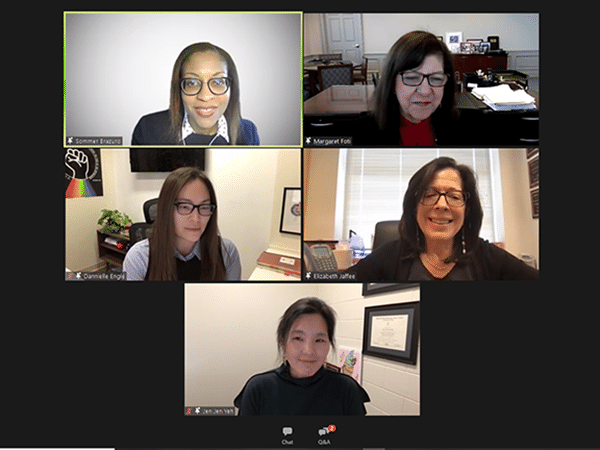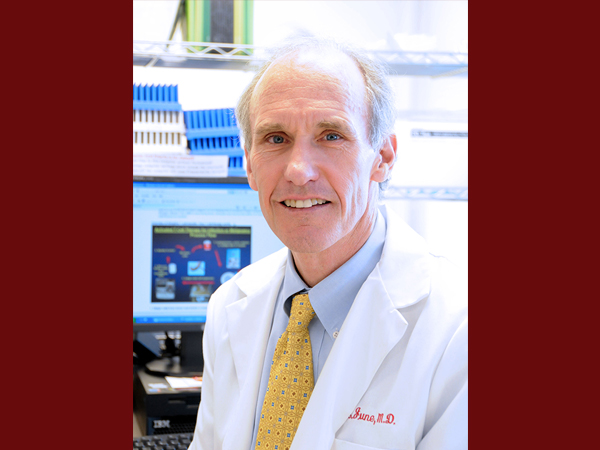Orchestrating an Antitumor Immune Response: A Preview of the Fifth International Cancer Immunotherapy Conference
Immunotherapy is a form of cancer treatment that helps a patient’s own immune system recognize and attack cancer cells. Research on different types of immunotherapy has exploded over the past decade, and such approaches have proven to be successful for many patients. However, challenges remain, including a lack of response in some patients, development of resistance, and difficulties using certain immunotherapies in solid tumors.
Since 2015, the American Association for Cancer Research (AACR) has collaborated with the Cancer Research Institute (CRI), the Association for Cancer Immunotherapy (CIMT), and the European Academy of Tumor Immunology (EATI) to bring together all stakeholders in the field, including scientists, clinicians, regulators, drug developers, and patient advocates, to discuss the latest advances in immunotherapy research and treatment.
The Fifth CRI-CIMT-EATI-AACR International Cancer Immunotherapy Conference: Translating Science into Survival will be held September 25-28 in Paris. The meeting will feature talks on cancer prevention, immune checkpoint blockers, cell- and non-cell-based immunotherapies, vaccination strategies, resistance mechanisms, and new targets, among other topics.
Ellen Puré, PhD, conference co-chair and professor at the University of Pennsylvania, shared her thoughts on the upcoming conference, the current state of immunotherapy research, and where it’s headed.
Cancer immunotherapy is currently an exciting area of research and medicine. Can you provide some background on why there is so much interest in this topic?
The excitement in the field of immunotherapy stems, in part, from the many years of skepticism about the immune system’s ability to both recognize and attack a tumor. There were both experimental reasons and epidemiologic evidence that made immunotherapy quite controversial for a very long time, but there were stalwarts that truly believed that the immune system could recognize cancer, and this recognition could be harnessed into effective anti-tumor activity. That has now been proven correct.
Another reason for the excitement is that there has been an exponential growth over the last decade of the various approaches one can use to harness the immune system, either by activating the immune system of the host or by introducing drugs that will act as an immune defense mechanism against cancer. Although immunotherapy is not yet a panacea, the amount of success has been notable. The more that we understand why some patients do not respond or become resistant to treatment, the more approaches we will have at our fingertips.
The third reason a lot of people are excited about immunotherapy is that we are mostly introducing biologic materials rather than treating with chemotherapies that have nonspecific toxicity. While we see some toxicity with immunotherapy, we may be able to control that as we learn more about it.
Finally, in addition to the promise of each individual therapy, the thought of using them in combination, either sequentially or even in parallel, is very promising. Sequential treatments could be used if patients develop resistance to an earlier treatment. By combining treatments, you could possibly use lower doses of the more toxic therapies to target multiple pathways that the cancer cells use to survive.
The conference includes a session on the use of combination therapies with immune checkpoint blockers. While immune checkpoint blockers have been successful for certain patients, there have been mixed results with combination therapies. What are the latest strategies to improve the efficacy of combination therapies?
The main principle is to understand at a basic mechanistic level the differences between the patients who respond and those that do not. Understanding the differences in response and identifying biomarkers will allow us to develop more individualized and precise treatment approaches. As we get that information, we need to have a stronger biological rationale for which combinations to try in which patients.
What are some of the latest advances in cell-based immunotherapies and understanding resistance mechanisms?
We are beginning to understand some of the resistance mechanisms that are in play with existing adoptive cell therapies, although I think we’ve probably only hit the tip of the iceberg. These mechanisms include mutations that make the therapy ineffective, downregulation of the target protein, and immune-cell exhaustion. We will be discussing all of these at the meeting.
In my opinion, a big goal for the next iteration of adoptive cell therapy is to use it against solid tumors. This approach has not been very successful so far due to a couple of reasons. One is the immunosuppressive environment set up by tumors. Another is the physical properties of solid tumors that can exclude T cells from accessing the tumor either through biochemical or biomechanical mechanisms.
An approach that we and others have taken is to increase T-cell access to tumor cells by manipulating the stroma, which forms the biochemical and biomechanical barrier. We’re attempting to disrupt the extracellular matrix using enzymes like hyaluronidases or collagenases or by manipulating the stromal cells that contribute to the barrier. The question then becomes, can we disrupt the stromal environment in a way that makes it penetrable to T cells and even promote T cell infiltration, and can we then combine this approach with other therapies that will attack the cancer cells? There is now proof of principle for this approach from our laboratory and others.
Can you speak to the progress made in other forms of immunotherapy, such as therapeutic vaccines and non-cell-based immunotherapies?
I truly believe vaccines will be one key approach. Vaccines educate our own immune system, which stays educated because it has a memory. In the same way that the immune system is more effective when you’re exposed to a pathogen the second time around, it would react quickly to cancer recurrence and/or metastasis because you’d have these memory immune cells around.
When vaccines were first tried, we were good at activating and expanding immune cells that could recognize the tumor antigen, but the immune cells weren’t effectively killing the cancer cells. As a result, many researchers stopped working on it, thinking that this approach would only work for viral tumors where there is a robust antigen.
Now we understand that one of the mechanisms that play a role in making vaccines ineffective is immune suppression. Because of this, I think one promising approach is to combine vaccines with checkpoint inhibitors or other modulators of the immune system that can boost immune activity or inhibit immune suppressive activity.
In addition to our understanding of the biology, the technological and bioinformatics strides that have been made recently have really allowed us to define the relevant tumor antigens to target. We have a session on vaccines at the meeting, as well as sessions that focus on related topics, including sequencing technologies and approaches to harness bioinformatics, which help to define tumor neoantigens.
“Cold” tumors, or those that lack tumor T-cell infiltration, are a major challenge to immunotherapy. What are the latest approaches to tackling this issue?
Disrupting the stromal barrier to promote T-cell infiltration into the tumor is definitely one approach, as we discussed earlier.
Another approach is to stimulate the immune system to enhance trafficking of immune cells, which is something we’re learning more about. The field is not as advanced at the moment for this approach, but it will come.
A third approach is to understand which molecular pathways or cells are responsible for the lack of tumor T-cell infiltration. A bigger focus recently has been on what is excluding T cells, but the other side of the coin to consider is the lack of environment that attract the T cells. The right chemoattractants and extracellular matrix have to be present for T cells to migrate into tumors. So, we have to understand what the attractants are and boost them.
If we understand the mechanisms of T-cell exclusion and attraction and can manipulate them, we’ll be able to get the T cells into every tumor. Probably the best example of this concept is that pancreatic cancers were long thought to be cold tumors. We now know that’s not true. There are manipulations that are leading to infiltration of T cells, even in pancreatic tumors.
The conference features sessions on crosstalk, metabolism, and the microbiome. What roles do these elements play in cancer prevention and treatment?
Metabolism is a very rapidly growing field. There is now enormous evidence that the overall microenvironment promotes metabolic changes that, in turn, promote tumor growth and/or prevent the activity of antitumor immune cells. Many researchers are focused on the metabolic effects within the tumor itself that occur as a consequence of having cancer. I think the first targeted therapies aimed at altering aberrant metabolic milieus will allow us to start making headway. Changes in metabolism also affect the response to immunotherapy, as well as to other therapies.
The other big breakthrough will come from the fact that risk factors like obesity, aging, other diseases, and smoking affect all the different things we’ve talked about: the microenvironment and the stromal cells.
These risk factors also cause unhealthy changes in metabolism that probably influence our susceptibility to cancer and determine the aggressiveness and metastasis of tumors. In the future, I think we’re going to understand more about the role that metabolic syndromes or changes associated with non-malignant conditions play in the transition from a tumor-resistant to a tumor-permissive microenvironment.
The conference features a session on cancer prevention and lifestyle factors in oncoimmunology. Can you speak to the significance of understanding the lifestyle factors that influence cancer risk?
There has been an incredible focus for many, many years on treating cancer, but we have done probably a little less on the prevention of cancer. I think the knowledge that we have gained now about factors such as the microbiome and metabolism will allow us to start thinking about prevention.
I’m really pleased that we have a session on cancer prevention and the lifestyle factors involved. I don’t think we’re ever going to cure all cancer; however, what we can do is have a major impact on lowering the risk factors and turning cancers into chronic diseases that we can keep in check.
Factors like obesity and high-fat diets are just another example of a stress on the system that leads to metabolic, stromal, and inflammatory changes. All of these increase cancer risk and contribute to tumor progression. Understanding these prevention and lifestyle factors is going to be extremely important in the long run – even past my time in science or on this earth.
Can you provide your thoughts on the future of the immunotherapy field?
There has been a big focus in the field of immunotherapy on the adaptive immune response because of the idea that you need cytolytic T cells specific to a tumor antigen in order to succeed. But you’re going to hear a lot at this meeting about how much of a role the innate immune system also plays in attacking tumors.
The other thing I expect to see is more integration of different disciplines. The systems immunology session at the meeting is a good example of that. Scientists often tend to have a reductionist approach in trying to figure out every minor detail, such as which proteins are signaling, what is phosphorylated, and which amino acid is involved. But sometimes we have to pull back and integrate. We need to understand that the individual components of the immune system work in concert, and we have to understand that integration at a higher order.
We can’t approach this like three sections of the orchestra that are playing independently; that would sound awful and be very ineffective. Instead, there has to be integration of different fields, and it has to be orchestrated in a way where we use the best of each field to amplify each other and be in harmony. I think integration at that higher order level is going to be the future of cancer research. It will also be a challenge, but one that we can handle.





